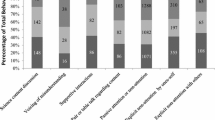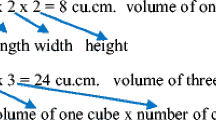Abstract
Previous research has demonstrated that Numbered Heads Together, a cooperative learning strategy, is more effective than traditional teacher-led instruction in academic areas such as social studies and science. The current study compared the effects of two types of Numbered Heads Together strategies with a baseline condition during 7th grade language arts lessons. Results indicated that three students with various disabilities had higher percent intervals of on-task behavior and daily quiz scores during either Heads Together condition. Teacher satisfaction ratings suggested that Heads Together was easy to implement, and all three students preferred this strategy to baseline instruction. A discussion of study limitations, implications, and future research directions is included.

Similar content being viewed by others

References
Barbetta, P. M., Heron, T. E., & Heward, W. L. (1993). Effects of active student response during error correction on the acquisition, maintenance, and generalization of sight words by students with developmental disabilities. Journal of Applied Behavior Analysis, 26(1), 111–119.
Barbetta, P. M., & Heward, W. L. (1993). Effects of active student response during error correction on the acquisition and maintenance of geography facts by elementary students with learning disabilities. Journal of Behavioral Education, 3(3), 217–233.
Barlow, D. H., & Hayes, S. C. (1979). Alternating treatments design: One strategy for comparing the effects of two treatments in a single subject. Journal of Applied Behavior Analysis, 12(2), 199–210.
Campbell, J. M. (2004). Statistical comparison of four effect sizes for single-subject designs. Behavior Modification, 28(2), 234–246.
Chapman, E. S., & Cope, M. T. (2004). Group reward contingencies and cooperative learning: Immediate and delayed effects on academic performance, self-esteem, and sociometric ratings. Social Psychology of Education, 7(1), 73–87.
Cooper, J. O., Heron, T. E., & Heward, W. L. (2007). Applied behavior analysis. Columbus, OH: Merrill Prentice Hall.
Coutinho, M. J. (1986). Reading achievement of students identified as behaviorally disordered at the secondary level. Behavioral Disorders, 11(4), 200–207.
Emmer, E. T., Evertson, C. M., & Brophy, J. E. (1979). Stability of teacher effects in junior high classrooms. American Educational Research Journal, 16(1), 71–75.
Fielding, L. G., & Pearson, D. P. (1994). Reading comprehension: What works. Educational Leadership, 51(5), 62–68.
Ghaith, G. M. (2001). Learners’ perceptions of their STAD cooperative experience. System, 29(2), 289–301.
Gunter, P. L., & Denny, R. K. (1998). Trends and issues in research regarding academic instruction of students with emotional behavioral disorders. Behavioral Disorders, 24(1), 44–50.
Haydon, T., Conroy, M. A., Sindelar, P. T., Scott, T. M., Barber, B., & Orlando, A. M. (2010). A comparison of three types of opportunities to respond on student academic and social behaviors. Journal of Emotional and Behavioral Disorders, 18(1), 27–40.
Hayling, C. C., Cook, C., Gresham, F. R., State, T., & Kern, L. (2008). An analysis of the status and stability of the behaviors of students with emotional and behavioral difficulties: A classroom direct observation study. Journal of Behavioral Education, 17(1), 24–42.
Housel, D. J. (2007). Document-based questions for reading comprehension and critical thinking. Westminster, CA: Teacher Created Resources, Inc.
Johnson, D. W., & Johnson, R. T. (1999). Making cooperative learning work. Theory into Practice, 38, 67–73.
Johnson, D. W., Johnson, R. T., & Holubec, E. (1991). Cooperation in the classroom. Edina, MN: Interaction Book Company.
Kagan, D. M. (1992). Professional growth among pre-service and beginning teachers. Review of Educational Research, 62(2), 129–169.
Kazdin, A. E. (1982). Single case research designs. New York: Oxford University Press.
Kelshaw-Levering, K., Sterling-Turner, H. E., Henry, J. R., & Skinner, C. H. (2000). Randomized interdependent group contingencies: Group reinforcement with a twist. Psychology in the Schools, 37(6), 523–533.
Kennedy, C. H. (2005). Single-case designs for educational research. Boston, MA: Allyn & Bacon.
Kentucky Department of Education. (2008). Kentucky administrative regulations: Special education programs. Frankfort, Kentucky: Kentucky Department of Education.
Lane, K., Wolery, M., Reichow, B., & Rogers, L. (2007). Describing baseline conditions: Suggestions for study reports. Journal of Behavioral Education, 16(3), 224–234.
Lerner, J., & Johns, B. (2009). Learning disabilities and related mild disabilities: Characteristics, teaching strategies and new directions (11th ed.). NY: Houghton Mifflin Harcourt Publishing Company.
Lockheed, M. E., Abigail, M. H., Harris, A. M., & Nemceff, W. P. (1983). Sex and social influences: Does sex function as a status characteristic in mixed-sex groups of children? Journal of Educational Psychology, 75(6), 877–888.
Maheady, L., Mallette, B., Harper, G. F., & Sacca, K. (1991). Heads together: A peer- mediated option for improving the academic achievement of heterogeneous learning groups. Remedial and Special Education, 12(2), 25–33.
Maheady, L., Michielli-Pendl, J., Harper, G. F., & Mallette, B. (2006). The effects of numbered heads together with and without an incentive package on the science test performance of a diverse group of sixth graders. Journal of Behavioral Education, 15(1), 25–39.
Maheady, L., Michielli-Pendl, J., Mallette, B., & Harper, G. F. (2002). A collaborative research project to improve the academic performance of a diverse sixth grade science class. Teacher Education and Special Education, 2(1), 55–70.
Mooney, P., Epstein, M. H., Reid, R., & Nelson, J. R. (2003). Status and trends of academic intervention research for students with emotional disturbance. Remedial and Special Education, 24(5), 273–287.
Mortweet, S. L., Utley, C. A., Walker, D., Dawson, H. L., Reddy, S. S., Greenwood, C. R., et al. (1999). Classwide peer tutoring: Teaching students with mild retardation in inclusive classrooms. Exceptional Children, 65(4), 524–536.
Nelson, J. R., Johnson, A., & Marchand-Martella, M. (1996). Effects of direct instruction, cooperative learning, and independent learning practices on the classroom behavior of students with behavioral disorders: A comparative analysis. Journal of Emotional and Behavioral Disorders, 4(1), 53–62.
No Child Left Behind Act of 2001, Pub. L. No. 107–110, 115 Stat. 1425 (2002).
Putnam, J. W. (1998). Cooperative learning and strategies for inclusion: Celebrating diversity in the classroom. Baltimore, ML: Brooks Publishing Inc.
Ryan, J. B., Reid, R., & Epstein, M. H. (2004). Peer-mediated intervention studies on academic achievement for students with EBD: A review. Remedial and Special Education, 25(6), 330–341.
Shaaban, K. (2006). An initial study of the effects of cooperative learning on reading comprehension, vocabulary acquisition, and motivation to read. Reading Psychology, 27(5), 377–403.
Slavin, R. E. (1995). Cooperative learning: Theory, research and practice (2nd ed.). Boston: Allyn and Bacon.
Sutherland, K. S., & Wehby, J. H. (2001). Exploring the relationship between increased opportunities to respond to academic requests and the academic and behavioral outcomes of students with EBD: A review. Remedial and Special Education, 22(2), 113–121.
Sutherland, K. S., Wehby, J. H., & Gunter, P. L. (2000). The effectiveness of cooperative learning with students with emotional behavior and behavioral disorders: A literature review. Behavioral Disorders, 25(3), 225–238.
Trout, A. L., Lienemann, T. O., Reid, R., & Epstein, M. H. (2007). A review of non-medication interventions to improve the academic performance of children and youth with ADHD. Remedial and Special Education, 28(4), 207–226.
Tucker, M., Sigafoos, J., & Bushell, H. (1998). Use of noncontingent reinforcement in the treatment of challenging behavior: A review and clinical guide. Behavior Modification, 22(4), 529–547.
U. S. Department of Education. (2001). Twenty-third annual report to Congress on the implementation of the Individuals with Disabilities Education Act. Washington, DC: U. S. Department of Education.
Wanzek, J., & Vaughn, S. (2009). Students demonstrating persistent low response to reading intervention: Three case studies. Learning Disabilities Research & Practice, 24(3), 151–163.
Webb, N. (1984). Sex differences in interaction and achievement in cooperative small groups. Journal of Educational Psychology, 76(1), 33–44.
Wehby, J. H., Lane, K. L., & Falk, K. B. (2003). Academic instruction for students with emotional and behavioral disorders. Journal of Emotional & Behavioral Disorders, 11(4), 194–197.
Acknowledgement
Preparation of this article was in part supported by the University of Cincinnati’s Research Council Grant.
Author information
Authors and Affiliations
Corresponding author
Rights and permissions
About this article
Cite this article
Haydon, T., Maheady, L. & Hunter, W. Effects of Numbered Heads Together on the Daily Quiz Scores and On-Task Behavior of Students with Disabilities. J Behav Educ 19, 222–238 (2010). https://doi.org/10.1007/s10864-010-9108-3
Published:
Issue Date:
DOI: https://doi.org/10.1007/s10864-010-9108-3



